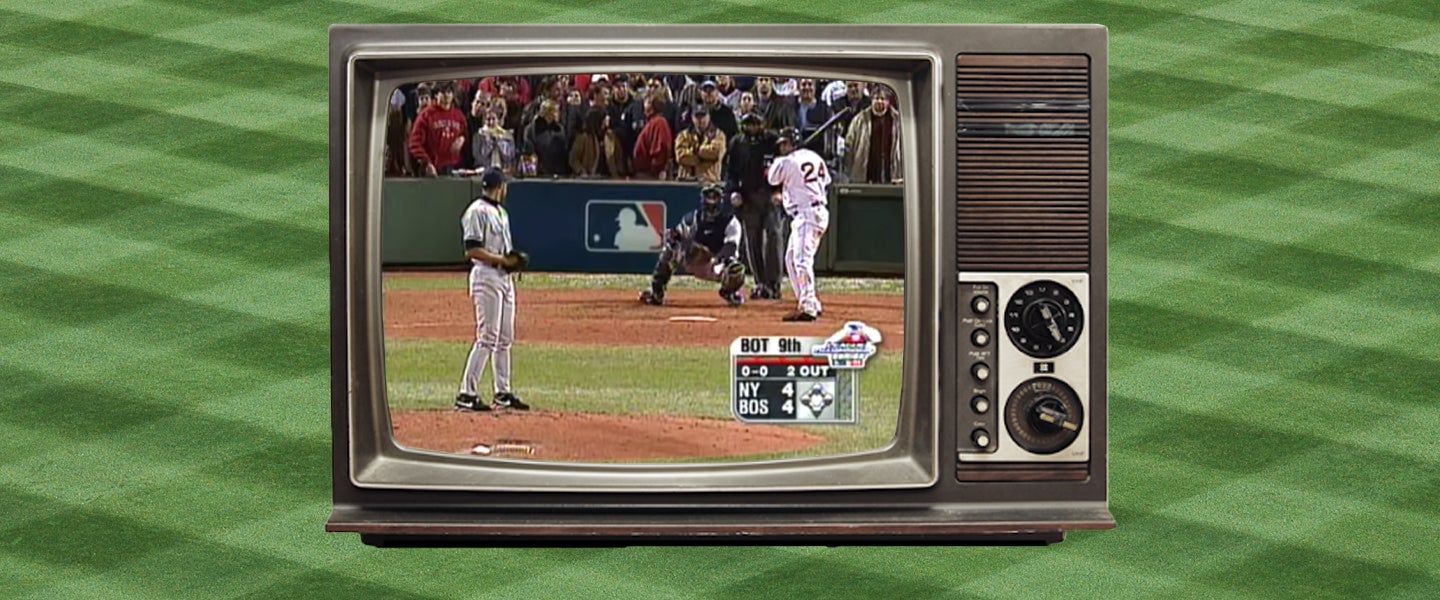If everything had gone according to plan, March 26th would’ve been Major League Baseball’s 2020 opening day. Instead, COVID-19 stopped even the spring training games cold a few weeks ago. If there is an MLB season this year — which looks increasingly unlikely — it’ll probably be more a series of exhibitions and tournaments than a traditional season. So right now, and for the near future, if fans want “real” baseball, we’ll have to settle for rebroadcasts of old games, on cable and on the internet.
Here’s how big a baseball fan I am: For me, “opening day” happened back in February, on the first day that MLB Network started airing spring training games. Until baseball shut down, I’d probably watched at least a few innings of one or two of those games a day. I’ve always enjoyed the peaceful rhythms of a ballgame on my TV, even in the background. There’s something calming — and satisfying — about seeing two teams fill up a box score with outs and runs. It’s a little like watching one of those YouTube videos where somebody cooks a meal or builds a piece of furniture or topples a long line of dominoes. The progression, the order… It all makes the world feel like it has a proper structure.
In the absence of new games, I’ve tried to approximate that feeling by revisiting MLB’s classic games. I can’t pretend this scratches the itch left by live baseball’s absence, but it appeals to different parts of me: the nostalgist, the historian and the person who appreciates irony.
There are multiple ways to enjoy watching old sporting events and some have little to do with sports. Most people (myself included) watch live sports in part for the drama. While the games’ structures and rhythms may be predictable, the outcomes remain uncertain. That element isn’t really a part of watching classic games, where the results are often spoiled by the program descriptions. Click on a YouTube video called “Tom Seaver’s No-Hitter,” and you know what you’re going to get. But you can still enjoy the aesthetics of Seaver’s pitching, and the way he baffled great hitters like Lou Brock, Ted Simmons and Keith Hernandez.
You can also enjoy seeing Hernandez in a 1978 Cardinals uniform, then later that same day on ESPN Classic see him playing with the 1986 Mets. Sports networks like MLB and ESPN have been airing old games in no particular chronological order, which can make the continuity of names from game to game a little jarring, but also kind of reassuring. One day you can be watching Pete Rose, Joe Morgan and Tony Pérez play together with the Reds, and the next day you can see the three of them playing for the Phillies. The day after that, you can watch a game that has Morgan sitting in the broadcast booth, offering analysis.
Watch any given MLB playoff game from the 1990s and 2000s and you’ll probably see David Justice, sparking his team in a Braves, Indians, Yankees or A’s uniform. You may find yourselves marveling at the durability of umpires, some of whom can be seen working games in the 1970s and the 2000s.
It’s just as fascinating to see the ways that baseball has changed across the decades — for better and for worse. Some of these trends are disappointing, like the way that baseball rosters in the more modern era feature far fewer African-American players than the rosters from the 1970s and 1980s did. Some changes are just strange, like the way that so many games used to be disrupted by fans throwing trash onto the field. (Once teams started moving en masse into fancy retro ballparks in the 1990s, the littering seemed to cease.) Some evolutions are more divisive, like the different stats announcers have focused on from era to era. For instance, it’s weird to watch some of the most gritty pitching performances of the past and never hear anyone in the broadcast booth say a word about pitch-counts.
In fact, in the days before the internet was everywhere, if a player approached some kind of momentous single-game record — like Kerry Wood or Roger Clemens striking out 20 batters — the announcers didn’t always have the information at their fingertips about whose records they might be breaking. In general, old broadcasts tended to be low on concrete information. If nothing else, I still find it hard to get used to watching an old ballgame without a score-box constantly in the corner of the screen.
Of course, the biggest differences between these games are the way they look and sound. The archive of old MLB telecasts is also a mini history of sports broadcasting, from the styles of the announcers to the look of the on-screen graphics. Until FOX Sports brought its flashy high-tech style to baseball in 1996, the on-screen text during games often looked embarrassingly cheap — like something you’d see in a corporate orientation video.
On the other hand, FOX’s hyperactive slickness hasn’t always worn well either. While watching one of the epic Yankees/Red Sox 2004 ALCS battles, it’s incredibly distracting to hear announcer Joe Buck consult his “WebMD symptom checker” to describe how a team or player might be feeling. And the less said about FOX’s “Scooter,” the animated baseball, the better.
Some announcers’ work has held up well. Al Michaels? Bob Costas? Both are still great. But while Howard Cosell’s contributions to sports broadcasting are indisputable, he had little knack for calling baseball games, because he focused too much on players’ personalities instead of on what they were actually doing. Also, hearing the now-retired Morgan do color commentary again — making snap judgments about what players failed to do, then refusing to relent even after replays didn’t back up his opinion — is an unwelcome reminder of why one of the most popular sports blogs of the 2000s was called “Fire Joe Morgan.”
But you know what?
Even these broadcasters’ failures are now poignant in unexpected ways. For one thing, these guys (and they’re all guys, alas) weren’t doing these telecasts for posterity. They were reporting on what was happening right in front of their eyes, with no thought to how their performances might look 10, 20 or 30 years later. If Keith Jackson had been thinking about someone like me, watching a 1986 NLCS game in 2020, he might’ve said things like, “Up next at bat for the Astros: Terry Puhl. … Dude, remember Terry Puhl?”
If possible, I recommend watching the full baseball broadcasts rather than the compressed versions, because it’s in the longer ones that you get the ephemeral stuff that makes re-experiencing an old game special. That Tom Seaver no-hitter, for example, takes place a couple of games after Pete Rose had begun his 44-game hit streak, which the announcers don’t note because they had no idea what kind of tear Rose was about to go on for the next six weeks. And during the game, they reported that the Atlanta Braves had just traded for reliever Gene Garber, who would be on the mound later that summer when Rose’s streak came to an end.
The announcers also didn’t know that Rose’s career would end in disgrace a decade later due to a gambling habit, and that even now he wouldn’t be enshrined in MLB’s Hall of Fame. When Clemens strikes out 20 at the start of the 1986 season, the announcers don’t know that the year will end in heartbreak for the Red Sox, due in part to the man playing first base for the team in that same game. When Wood strikes out 20 early in 1998 — in his rookie season, no less — the Cubs right fielder that day is Sammy Sosa, who would thrill the country that summer with his home run chase against Mark McGwire. Later, Clemens, Sosa and McGwire would be caught up in baseball’s steroid scandal, and Wood’s promising career would be derailed due to injury. The people broadcasting these games don’t know this. They can’t know.
So this becomes the new pleasure in watching recorded baseball games instead of live ones: the little ironies, the little surprises. I know how these games are going to end, but I don’t know how the people watching them and talking about them are going to react, or what they’re going to say. They couldn’t see the bigger picture then, just as I can’t see it now. And as someone who doesn’t know what tomorrow will bring, I appreciate being reminded that no matter the era — on and off any particular playing field — we’ve never really had any guarantee about what’s going to happen next.

